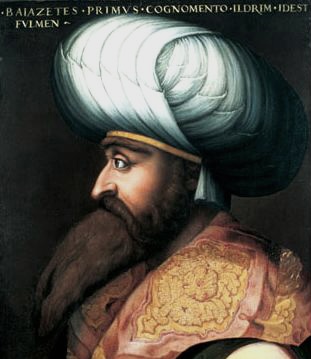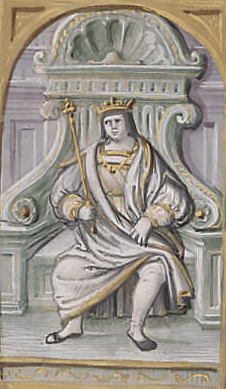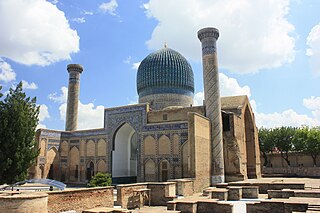Relations with Spanish and French kingdoms
Prior to the Battle of Ankara, as the Hundred Years' War was going through a quiet phase, many European knights and men-at-arms sought adventure abroad and some of these ended up serving in Tamerlane's armies. There is one recorded instance of a French squire by the name of Jacques du Fey who served under Timur though the exact circumstances of his service are unknown. What is known is that Timur released him so he could rejoin his countrymen for the crusade against the Ottomans which ended in disastrous failure at the Battle of Nicopolis. After the battle, the Ottoman sultan ordered many prisoners to be executed but Tartar warriors, sent by Timur to answer the Ottomans' call for Jihad, recognized Jacques du Fey and were able to save him from execution.
At the time of the Battle of Ankara, two Spanish ambassadors were already with Timur: Pelayo de Sotomayor and Fernando de Palazuelos. [3] There was the possibility of an alliance between Timur and the European states against the Ottoman Turks attacking Europe. There was a clear motive for Timur, who wanted to surround his Ottoman and Mamluk enemies in an offensive alliance.
These mirrored attempts towards a Franco-Mongol alliance a century before. [2] [4] [5] [6]
Timur sent an ambassador to the court of Charles VI, in the person of the Dominican friar Jean, Archbishop of Sultānīya. [5] Jean arrived in Paris on 15 June 1403. [5] Timur's letter was delivered to Charles VI, describing him as:
"The most serene, most victorious King and Sultan, the king of the French and many other nations, the friend of the Most-High, the very beneficent monarch of the world, who has emerged triumphant from many great wars."
—
Letter from Timur to Charles VI. [1]
Timur offered an offensive and defensive alliance to Charles VI, as well as the development of commercial relations. Charles VI was only able to send an answer and an envoy shortly before Timur's death (1405). [7]
Relations with Spain were also developed. [1] In the view of the Spanish historian Miguel Ángel Ochoa Brun, the relations between the courts of Henry III of Castile and that of Timur were the most important episode of the mediaeval Castilian diplomacy. [8] Timur sent to the court of Castile a Chagatay ambassador named Hajji Muhammad al-Qazi with letters and gifts. [1] [3]
In December 1402, Timur came into direct conflict with a small European outpost on the Anatolian coast. The fortress and harbour of the city of Smyrna were held by the Knights Hospitaller. Timur besieged Smyrna for a fortnight and captured it. This action caused some consternation in Aragon and Castile.
Embassy of Ruy González de Clavijo
In return, King Henry III of Castile sent an embassy to Timur's court in Samarkand on 21 May 1403, led by Ruy González de Clavijo, with two other ambassadors, Alfonso Paez and Gomez de Salazar. [1] [4] [5] On their return in 1406, Timur said that he regarded the king of Spain "as his very own son". [1]
According to Clavijo, Timur's good treatment of the Spanish delegation contrasted with the disdain shown by his host toward the envoys of the "lord of Cathay" (i.e., the Ming dynasty Yongle Emperor). The Chinese ruler, whose title was "lord of the realms of the face of the earth", [9] was called by Timur (to Clavijo's face) a "thief and a bad man", and his ambassadors were seated below the Spaniards. [10]
Clavijo's visit to Samarkand allowed him to report to the European audience on the news from Cathay (China), which few Europeans had been able to visit directly in the century that had passed since the travels of Marco Polo. Clavijo's account reported, even if in a garbled form, on the recent civil war between the descendants of the Hongwu Emperor. The Spanish were able to talk to some of the Chinese visitors, and learned about the caravan routes between Samarkand and Cambalu (Beijing). [11] Besides telling the European readers about the Cathayan capital Cambalu, which he was told was "the largest city in the world", and the mighty armies of that country, Clavijo also—mistakenly—reported that the new emperor of Cathay had converted to Catholicism. [11] Thus his report served as one of the factors supporting the European belief in the widespread presence of Christianity in Cathay, which was to persist until the early 17th century and to be one of the reasons for sending the famed Bento de Góis expedition in 1603.
Relations after Timur
Timur died in 1405, and his son Shah Rukh continued to campaign against the Ottomans, creating hope in the Christian West that the invading Ottoman Empire might be diverted away from Europe. [12]
A Bavarian adventurer, Johann Schiltberger, is known to have remained in the service of Timur from 1402 to 1405. [5] Also, numerous Venetian and Genoese traders were active in Sultaniya at that time, since the time of their establishment in Sultaniya under the Il-Khanids. [3]
The next contacts between Europe and Persia would be those of the Venetian traveler Niccolo da Conti from 1420 to 1425. [3] Contacts failed to develop much further thereafter, although Spain's desire for rapprochement with the Mongols remained until the time of Christopher Columbus in 1492, whose objective was to reach the Great Khan in China. [1]
The story of Tamerlane has a long legacy associated with Orientalism in Europe, with such publications as Tamburlaine the Great by Christopher Marlowe in 1590 and Handel's opera Tamerlano in 1724. [2]

Bayezid I, also known as Bayezid the Thunderbolt, was the sultan of the Ottoman Empire from 1389 to 1402. He adopted the title of Sultan-i Rûm, Rûm being the Arabic name for the Eastern Roman Empire. In 1394, Bayezid unsuccessfully besieged Constantinople. He defeated the Crusaders at the Battle of Nicopolis in what is now Bulgaria in 1396. He was later defeated and captured by Timur at the Battle of Ankara in 1402 and died in captivity in March 1403, which triggered the Ottoman Interregnum.
Year 1403 (MCDIII) was a common year starting on Monday of the Julian calendar.

Samarqand or Samarkand is a city in southeastern Uzbekistan and among the oldest continuously inhabited cities in Central Asia. Samarqand is the capital of Samarqand Region and a district-level city, that includes the urban-type settlements Kimyogarlar, Farhod and Khishrav. With 551,700 inhabitants (2021), it is the second-largest city of Uzbekistan. Most of the inhabitants of the city are native speakers of the Tajik dialect of the Persian language, although Uzbek is spoken as a second language.

Henry III of Castile, called the Suffering due to his ill health, was the son of John I and Eleanor of Aragon. He succeeded his father as King of Castile in 1390.

The Timurid Empire was a late medieval, culturally Persianate Turco-Mongol empire that dominated Greater Iran in the early 15th century, comprising modern-day Iran, Iraq, Afghanistan, much of Central Asia, the South Caucasus, as well as parts of contemporary Pakistan, North India and Turkey. The empire was culturally hybrid, combining Turko-Mongolian and Persianate influences, with the last members of the dynasty being "regarded as ideal Perso-Islamic rulers".

The Gūr-i Amīr or Guri Amir is a mausoleum of the Turco-Mongol conqueror Timur in Samarkand, Uzbekistan. It occupies an important place in the history of Central Asian architecture as the precursor for and had influence on later Great Mughal architecture tombs, including Gardens of Babur in Kabul, Humayun's Tomb in Delhi and the Taj Mahal in Agra, built by Timur's Indian descendants, Turco-Mongols that followed Indian culture with Central Asian influences. Mughals established the ruling Mughal dynasty of the Indian subcontinent. The mausoleum has been heavily restored.

Ruy González de Clavijo was a Castilian traveler and writer. In 1403–05 Clavijo was the ambassador of Henry III of Castile to the court of Timur, founder and ruler of the Timurid Empire. A diary of the journey, perhaps based on detailed notes kept while traveling, was later published in Spanish in 1582 and in English in 1859.

Manuel III Megas Komnenos was Emperor of Trebizond from 20 March, 1390 to his death in 1417.

Bento de Góis, was a Portuguese Jesuit missionary and explorer. His name is commonly given in English as Bento de Goes or Bento de Goës; in the past, it has also been Anglicized as Benedict Goës.

Öljaitü, also known as Mohammad-e Khodabande, was the eighth Ilkhanid dynasty ruler from 1304 to 1316 in Tabriz, Iran. His name means 'blessed' in the Mongolian language.

Francesco II Gattilusio was the second Gattilusio lord of Lesbos, from 1384 to his death. He was the third son of Francesco I Gattilusio and Maria Palaiologina, the sister of the Byzantine emperor John V Palaiologos.

Timur or Tamerlane was a Turco-Mongol conqueror who founded the Timurid Empire in and around modern-day Afghanistan, Iran, and Central Asia, becoming the first ruler of the Timurid dynasty. An undefeated commander, he is widely regarded as one of the greatest military leaders and tacticians in history, as well as one of the most brutal and deadly. Timur is also considered a great patron of art and architecture as he interacted with intellectuals such as Ibn Khaldun, Hafez, and Hafiz-i Abru and his reign introduced the Timurid Renaissance.
Beylik of Erzincan was a principality in East Anatolia, Turkey in the fourteenth and early fifteenth centuries.

Saray Mulk Khanum was the empress consort of the Timurid Empire as the chief consort of Timur, also known as Tamerlane the Great, the founder of the Timurid Empire as well as the Timurid dynasty.

The siege of Smyrna was fought between the Knights of Rhodes, who held the harbour and sea-castle of Smyrna in western Anatolia, and the army of the Turco-Mongol emir Timur. The Turco-Mongols blockaded the harbour and attacked the fortifications with stone-throwing siege engines, while the defenders, numbering only about 200 knights, countered with arrows and incendiary projectiles. After two weeks of strong resistance against a far superior adversary, the outer wall was destroyed by mining and breached. Some of the garrison managed to escape by sea, but the inhabitants and the city itself were destroyed.
Sevin Beg Khanzada, also known as Khanzada, was a princess of the Sufi dynasty, the ruling Turco-Mongol dynasty of Khwarezm, and daughter-in-law twice-over to the Central Asian conqueror Timur through her marriages to his sons Jahangir and Miran Shah. Through her maternal grandfather Jani Beg, she was a direct descendant of Genghis Khan.

Iran–Spain relations are the bilateral and diplomatic relations between these two countries. Iran has an embassy in Madrid, Spain has an embassy in Tehran.

Spain–Uzbekistan relations are the bilateral and diplomatic relations between these two countries. Uzbekistan has an embassy in Madrid and honorary consulates in Madrid and Barcelona. The Spanish embassy in Moscow, Russia is also accredited for Uzbekistan. The Uzbek ambassador, Rakhmatulla Nurimbetov, declared that relations between the two countries have a "great potential not used", especially in agricultural, tourism and scientific matters, so he has invited the Spanish businessmen to "invest and contribute to the development of the country", such as companies Talgo and Marsans, and has expressed his desire that Spain open an Embassy in Tashkent "In the near future".
Hernán Sánchez de Palazuelos was an ambassador in the service of Henry III, the King of Castille. He is best known as part of the diplomatic mission to the Turco-Mongol conqueror Tamerlane.
Angelina de Grecia was a woman of Balkan origin who later established herself in Segovia.















